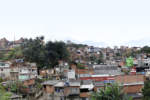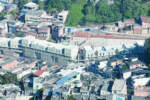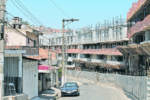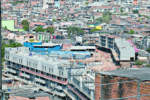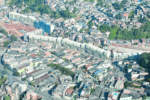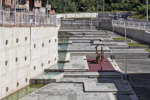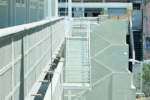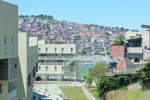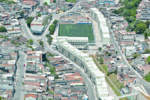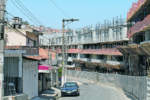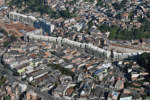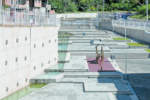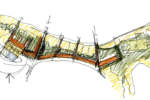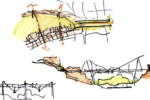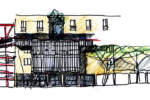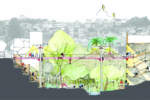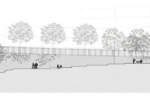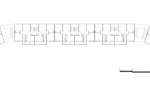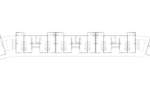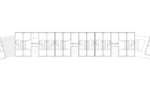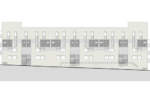architect: Vigliecca & Associados
location: São Paulo, Brasil
We understand residence as a synonym of city. And we do understand that housing production on a large scale constitutes a basic part of the city production.
Collective architecture projects must generate comprehensible and visible sectors willing to organize the scale by confronting the real city and rejecting heroic formalities.
We believe that housing production must value the variety and the identity, which can be reached through a respectable relationship with geography and solidarity with the existent.
The project is located in the south area of Sao Paulo Municipality, in Guarapiranga dam region, within a protected water spring area. The intervention area totalizes 5.4 ha, and it is inserted into a Special Zone of Social Interest (ZEIS 1). It is formed by public areas and irregularly occupied plot settlements.
The project general guideline objective is the creation, along the existing watercourse, of a green central axis, characterized as a linear park, structuring the whole intervention group. It is designed as an animated axis that qualifies the area, stimulating an identification feeling toward its inhabitants.
Both leisure and educational equipment are installed at the axis edges, working as attraction points in order to stimulate the people to circulate and, therefore, to guarantee the place security as well as its entertainment.
The housing buildings compose the interface between the official street of the surroundings and the park internal area. They are comprised of access on both sides in order to assure the circulation, and, consequently, the security and maintenance of the external-internal areas of the complex.
Each place is a place to live
interview to Héctor Vigliecca by Katia Carlucci
Katia Carlucci: If we compare one of your first social housing projects in Uruguay, the Complejo Bulevar, and this last project in Brazil, the Parque Novo Santo Amaro V, what different problems have you encountered and how have you solved them?
Héctor Vigliecca: These are realities that require different solutions and different reflections. Complejo Bulevar Artigas was intended for the middle class, organized into cooperatives and with a minimum capital savings required to access the program. Also, these operations were organized by the government and the Ministry of Housing.
The legal and social organization, hiring of technicians and supervisory works were managed by private institutes which became a model overseas. As architects, we participated intensively in all these activities, but our focus was architecture and urbanism projects. At this time, the best experience was to create housing typologies that were adaptable to family changes, as the social mobility in Uruguay was very low (a married son still used to live with his parents for a long time; it was an economic issue, and many professionals worked in their own houses). Once, on Sunday, we gathered all future owners in the largest Montevideo’s cinema.
We explained the typologies on the projection screen, and each family made their most appropriate option, resulting in 135 variants plant, to the despair of the construction companies.
Favelas’ reality in Brazil requires an ongoing and continuous reflection because of the speed of social changes, which is extremely fast and not easy to understand. Favelas are inserted in areas which are totally excluded from urbanization. In Parque Novo Santo Amaro V, the main challenge was to make appropriate housing in manancial area (risk area) occupied improperly. We needed more than the traditional housing typologie. Children have to run up and down stairs to have access to the school. In this project, bridges were proposed to link the existing and the implemented centralities. It is worth mentioning the experimental nature of this project. Few experiments conducted by the government face this issue.
K.C.: How much does the participation of the community matter in the architectural decisions related to your projects aimed at upgrading shantytown?
H.V.: The community is usually present in the definition of the Housing’s Program. The degree of involvement depends on the kind of Housing Program that included the project, as well as efficiency in the conduct population organizations.
The government is responsible for implementing the political participation of communities, promoting debates that must encompass the various scales of the territory.
K.C.: What are the most important projects you have realized in order to intervene in and/or upgrade shantytown?
H.V.: Some of the significant projects in the area of favela urbanization conducted by us were Paraisópolis, Heliópolis, Jardim Novo Santo Amaro e Jardim Vicentina (in Osasco, São Paulo metropolitan area). Heliópolis and Paraisópolis are the two largest favelas of the city, with 100 and 80,000 inhabitants, respectively.
From the viewpoint of the strategies, some of which were in the reference are:
a. Reestablish a legible and equipped urban net with a coherent public transport mobility.
b. Insert architectures as “infiltration wedges” avoiding large urban interventions as isolated objects.
c. Formulate jointly housing projects and urban design, to construct territory, and facilitate dynamic public place.
K.C.: An “exceptional” phenomenon occurred in Italy about 20 years ago: the old urban centers which had been abandoned have been repopulated by people from the middle and upper classes, who have renovated them.
Do you believe that favelas may see a similar phenomenon in the future?
On the other hand, the Rio favela, for instance, has a wonderful sea view...
H.V.: Favelas in São Paulo, Rio and cities in the Northeast region of the country have totally different realities, both geographically and socially. In Rio de Janeiro case, where there aren’t large areas for new development, favelas represent irreversible demands for urbanization. But there is a huge difference between repopulate a historic center and think about the future of the favelas.
Our perspective is that favelas become neighborhoods, like others of the formal city. If we reach this goal we will have advanced greatly.
K.C.: What is your most usual approach when designing for favelas? Renovation or relocation? Top-down planning or participation?
H.V.: We adopt a method in which, from an urban reading, it first establishes a hypothesis of town, so we can generate a model created on notice that the place itself reveals. The perspective is that people keep living where they already have lived and the relocation is made in cases of flooded areas, risk of falls or because of the urban structure adopted. Each place is a place to live.
K.C.: Does a contemporary architect find interesting arguments in the structures of favelas?
H.V.: There aren’t interesting arguments in the favelas structures. They are structures of misery. We consider deplorable architects formulation which see poetry in misery. Our mission is not to replace existing structures, or use them as a model. Our mission is to distinguish the value expressions of what is pathological.



